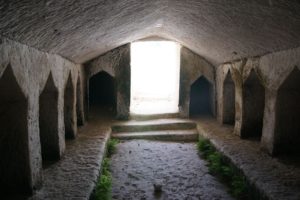Underground Metropolis: The Subterranean World of Maresha, Amos Kloner, Biblical Archaeology Review (23:2), Mar/Apr 1997.

Maresha Northern Cemetery, By Mboesch – Own work, CC BY-SA 4.0, https://commons.wikimedia.org/w/index.php?curid=37789377
Much of our work at the site of Maresha takes place underground—in tombs and in caves.1 BAR readers will not be surprised by the number of tombs, two of them with their walls covered with spectacular paintings. Much less common, however, are Maresha’s hundreds of caves. The subterranean labyrinth of spacious halls, small chambers, extensive winding corridors and industrial installations has led some to call Maresha an underground city.
Maresha lies in the heart of the Shephelah, the rolling hills of Judah between the coastal plain and the mountains in central Canaan, about a thousand feet above sea level, 27 miles from the Mediterranean, 35 miles south of Jerusalem, less than 4 miles northeast of the major Judahite city of Lachish and just outside the modern kibbutz of Beit Guvrin. The site consists of an upper city (the tell) and, surrounding the tell, a lower city, which includes the underground caves. Most of the underground caves and painted tombs date to the Hellenistic period (third to second century B.C.E.).
Joshua 15-44 describes Maresha as one of the Canaanite cities allotted to the tribe of Judah. Solomon’s son Rehoboam, the Bible also tells us, fortified Maresha as a defense against potential Egyptian aggression (2 Chronicles 11-5–12).
Read the rest of Underground Metropolis: The Subterranean World of Maresha in the online Biblical Archaeology Society Library.



